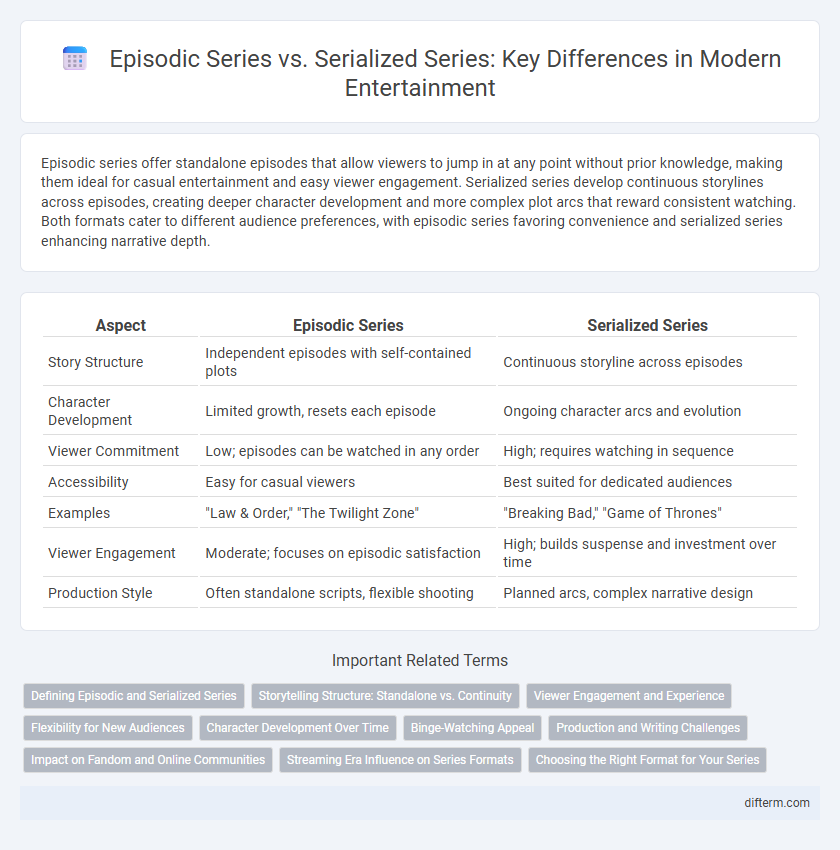Episodic series offer standalone episodes that allow viewers to jump in at any point without prior knowledge, making them ideal for casual entertainment and easy viewer engagement. Serialized series develop continuous storylines across episodes, creating deeper character development and more complex plot arcs that reward consistent watching. Both formats cater to different audience preferences, with episodic series favoring convenience and serialized series enhancing narrative depth.
Table of Comparison
| Aspect | Episodic Series | Serialized Series |
|---|---|---|
| Story Structure | Independent episodes with self-contained plots | Continuous storyline across episodes |
| Character Development | Limited growth, resets each episode | Ongoing character arcs and evolution |
| Viewer Commitment | Low; episodes can be watched in any order | High; requires watching in sequence |
| Accessibility | Easy for casual viewers | Best suited for dedicated audiences |
| Examples | "Law & Order," "The Twilight Zone" | "Breaking Bad," "Game of Thrones" |
| Viewer Engagement | Moderate; focuses on episodic satisfaction | High; builds suspense and investment over time |
| Production Style | Often standalone scripts, flexible shooting | Planned arcs, complex narrative design |
Defining Episodic and Serialized Series
Episodic series feature self-contained episodes where each story concludes within a single installment, making them easy to watch out of order. Serialized series develop a continuous narrative across multiple episodes, requiring sequential viewing to understand character arcs and plot progression. This distinction impacts viewer engagement and binge-watching habits in the entertainment industry.
Storytelling Structure: Standalone vs. Continuity
Episodic series feature standalone stories within each episode, allowing viewers to enjoy content without prior context, focusing on self-contained plots and character development. Serialized series emphasize continuity, weaving complex story arcs and character progression across multiple episodes that require sequential viewing for full understanding. This storytelling structure influences audience engagement, with episodic series offering flexible viewing and serialized series promoting deeper investment over time.
Viewer Engagement and Experience
Episodic series offer self-contained stories in each episode, allowing viewers to easily jump in and enjoy without prior knowledge, which keeps casual audiences engaged. Serialized series build complex, interconnected narratives requiring consistent viewing, fostering deeper emotional investment and long-term commitment from fans. The choice between episodic and serialized formats significantly influences viewer retention, binge-watching tendencies, and overall audience satisfaction in entertainment.
Flexibility for New Audiences
Episodic series offer greater flexibility for new audiences by allowing viewers to jump into any episode without needing prior context, making it easier to attract casual or latecomer viewers. Serialized series, in contrast, require consistent viewing from the beginning due to their continuous story arcs, which can be a barrier for new audiences unfamiliar with previous episodes. Streaming platforms increasingly favor episodic formats to boost accessibility and viewer retention among diverse and time-constrained audiences.
Character Development Over Time
Episodic series allow characters to maintain consistent traits, with individual episodes often resolving conflicts independently, aiding casual viewers in understanding storylines. Serialized series emphasize continuous character growth and evolving relationships, creating deeper emotional investment through interconnected plotlines spanning multiple episodes. This format enables complex character arcs and long-term development, appealing to audiences who engage with ongoing narratives.
Binge-Watching Appeal
Episodic series offer self-contained stories in each episode, making it easy for viewers to jump in at any point without confusion, which appeals to casual binge-watchers seeking quick entertainment. Serialized series build complex, interconnected narratives across episodes, encouraging dedicated viewers to binge-watch entire seasons to fully grasp character development and plot twists. The continuous storytelling in serialized series often results in higher viewer engagement and retention, catering to binge-watchers who crave immersive, long-term narrative experiences.
Production and Writing Challenges
Episodic series require production teams to create self-contained stories that resolve within a single episode, posing challenges in consistently delivering fresh content that appeals to diverse audience preferences. Serialized series demand a cohesive narrative arc across multiple episodes, making writing complex due to the need for intricate plot development, character growth, and continuity management. Balancing pacing with character depth and ensuring production schedules align with evolving scripts are critical challenges unique to serialized storytelling.
Impact on Fandom and Online Communities
Episodic series foster diverse fan discussions by allowing viewers to engage with self-contained stories, making it easier for newcomers to join conversations at any point. Serialized series generate intense, continuous online fandom activity due to their complex, evolving plots that encourage speculation, theory-crafting, and deeper character analysis. The sustained engagement in serialized narratives often leads to robust fan communities on platforms like Reddit, Twitter, and Discord, driving higher fan loyalty and content creation.
Streaming Era Influence on Series Formats
Streaming platforms have revolutionized episodic and serialized series by enabling binge-watching, which favors serialized storytelling with continuous plotlines and character development. Episodic series maintain standalone episodes appealing to casual viewers, but the streaming era's emphasis on audience retention drives creators to adopt serialized formats for enhanced engagement. Data shows serialized series often achieve higher completion rates and viewer loyalty on platforms like Netflix and Hulu.
Choosing the Right Format for Your Series
Episodic series feature self-contained episodes with a clear beginning, middle, and end, ideal for viewers seeking standalone stories and casual watching. Serialized series develop continuous story arcs across episodes, providing deep character development and plot complexity that engage dedicated audiences. Choosing the right format depends on target audience preferences, storytelling goals, and distribution platforms.
episodic series vs serialized series Infographic

 difterm.com
difterm.com